| When
I was very young, as a
special treat, I was
taken to see the Festival
Ballet’s performance
of Where the rainbow
ends. This was a
series of short ballet
pieces, which were
produced each Christmas
time at that time. Where
the rainbow ends
was written as a
children’s play for
presentation at Christmas
in 1911 by Clifford
Mills and John
Ramsey with
incidental music by Roger
Quilter. It premiered
at the Savoy Theatre with
a cast including Noel
Coward and Jack
Hawkins. In 1921, it
was filmed with Roger
Livesey appearing in
one of his first
performances. The story
is of some children
separated from their
parents who journey on a magic
carpet and face
numerous difficulties and
are aided by Saint
George. The story
apparently contained
themes that would be
considered politically
incorrect today, which
perhaps accounts for its
decline from favour. It
was later turned into a
ballet and formed part of
the repertoire of the English
Ballet Company, later
the Festival Ballet, which
was formed by Alicia
Markova and Anton
Dolin and presented
regularly at around
Christmas in the 1950s. I
believe that I saw it
either in 1950 or 1951.
.
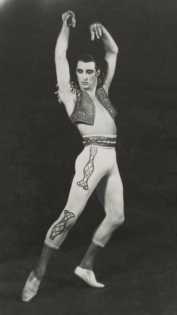 |
|
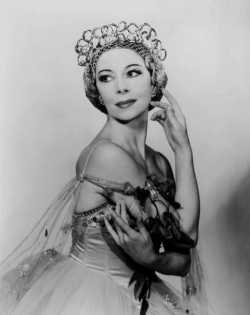 |
|
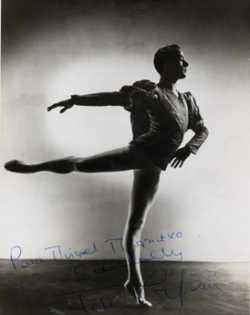 |
| Anton
Dolin |
|
Alicia
Markova |
|
John
Gilpin |
I
am sorry to say that I
did not see this outing
as a treat.
This was to be my first
proper experience with real
ballet and I was not
looking forward to it at
all. In fact, it would be
better to describe it as
my first confrontation
with the ballet. Prior
to this, I had seen bits
and pieces at the Hackney
Empire, but had not
been especially impressed
with the so-called art
form. I was not taken
with groups of young
women running about the
stage in white dresses
seemingly without purpose
and could not understand
why they did almost
everything en points.
I was also decidedly
unimpressed with the dirge
music that they
supposedly danced to.
Whenever I had to sit
through such dancing, I
would fidget and fuss and
would most often get a
light slap on the legs
along with a strong
request to be still. I
was annoyed that these
women were wasting my
time. Here we were at the
Hackney! I had
come to see magicians and
jugglers and to
see my favourite
comedians and singers and
not to have my time
wasted by these so-called
danseuses. At the
time, my tastes were
simple and decidedly
unsophisticated. To me, dancing
meant scantily clad
chorus girls performing
high kicks and dancing in
a line or else meant screaming
banshees flinging
themselves around the
stage between high
leg-kicks for, even
at that young age, I had
become a devotee of
the Can-Can! You
would be right in
deducing that I had
strong and definite
opinions even then.
I
remember that my attitude
towards this treat annoyed
my mother. Taking me to
see the ballet was
part of her plan to educate me and expose me
to a wide range of
cultural experiences. To
be honest, I doubt if my
mother would have used
those exact words. For
her, educated people
went to the ballet, and
since she was determined
to see that I got
educated, I was going
to the ballet whether I
liked it or not.
Naturally my mother had
never been exposed to
anything of this nature
and so was looking
forward to it and was
determined to enjoy it.
My father was none too
fussed about going
to the ballet and
preferred to stay home to
open the pie
‘n’ mash shop as
per usual. I
remember, years later,
when I was living in
Paris, when my parents
visited me I took them to
the Opera de Paris. I
had chosen the opera with
care. My father professed
to enjoy the music of Puccini and could often be
heard singing Nessun
Dorma when he went into the
bathroom. I was
overjoyed to see that Turandot was to be presented
during their visit and so
booked a centre box.
My mother was very
excited at the thought of
going to the opera while
my father seemed less
than enthused. Once the
lights went out, it did
not take long for loud
snores to come from
my father’s
direction. My mother was
furious with him and dug
him in the ribs many
times in the hope of
waking him. Eventually,
she gave up and he was
allowed to sleep through
the remainder of the
performance. Amusingly,
he told us at the end of
the performance how much
he had enjoyed hearing
good music for a change!
|
|
|
| |
| The year
when I was taken to see Where
the rainbow ends, it
was produced at the Stoll
Theatre in Kingsway. I remember the theatre
well, as its grandeur
left a marked impression
on me. It was a
magnificent theatre,
which was built in 1911
by Oscar Hammerstein and
named the London Opera
House and was hoped
to rival the Covent
Garden, but failed to
do so. The theatre
interior was ornate in
the French Renaissance style and designed by Bertie Crew. It
seated over two thousand
people in the twenty-two boxes,
stalls, dress circle,
upper circle and gallery. The stage was
eighty-three feet deep
and there were thirteen dressing
rooms for a possible
seventy-six artistes. In
1916, Oswald Stoll acquired
the theatre and
eventually turned it into The Stoll Picture
Theatre and presented
stage shows with a film.
In 1941, it became a
theatre once more and
following the death of Oswald
Stoll in 1942, Emile
Littler (Prince Littler) took
over its running and
renamed it the Stoll
Theatre. The theatre
housed many original
productions as well as
transfers from other
London theatres. It was
here that I saw Oklahoma! following its
transfer from the Theatre
Royal Drury Lane. The
theatre closed in 1957
after having been bought
by a development company
and was demolished in
1958. |
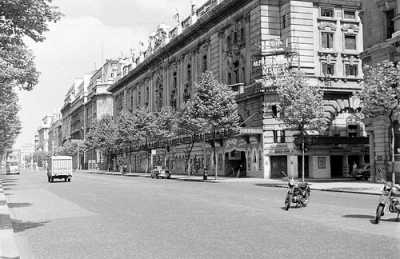 |
|
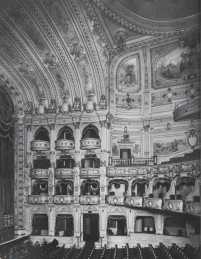 |
|
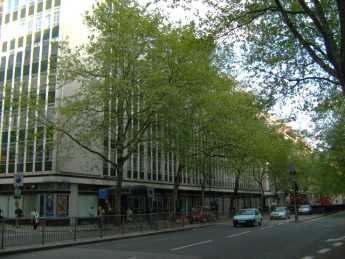 |
| The Stoll
Theatre - exterior |
|
The Stoll
Theatre - auditorium
(Picture
courtesy of Ken Roe) |
|
The site
of The Stoll Theatre
today |
I
remember being awe-struck
by the sheer majestic
grandeur of the theatre.
The foyer was a
mass of activities as
people left their cloaks
for collection later,
programme sellers barked
their wares and
people chattered
excitedly about the
coming attraction.
Amongst the potential
audience were groups of
school girls. Each one
was dressed in her school
uniform and had neatly
brushed long blonde hair,
as I remember. I am sure
that they attended private
schools since I
don’t think state
schools were into
taking kids on field
trips, as they are
called nowadays, to the
theatre. On reflection, I
suspect that many of
these young girls were ballerinas-in-training
and were eager to learn
from the masters. I
remember that they
chattered incessantly and
giggled a lot whereupon Madame,
their teacher, hushed
them. They were instantly
silenced and lowered
their eyes in shame. I
was struck by their upright
stance as they stood
talking and by their long
swan-like necks. I
assume now that their
teachers had cultivated
these features in them in
preparation for their
taking their place in the
corps de ballet later
in life. Fortunately, as
my mother and I made our
way to the auditorium,
these groups of gaggling
geese went up to the circles
while we went
elsewhere. Although I was
not looking forward to
the production,
nevertheless I did not
want any enjoyment that I
might get being
interfered with by
distracts from behind by
gangs of yapping girls!
Once we
entered the auditorium,
I was stunned by its
décor. The Hackney is
magnificent, but this
theatre certainly was
able to rival it for
sheer extravagance
and ornateness.
And at my young age, this
was just the sort of style
that impressed me.
Happily, I had not come
to understand the meaning
of the word ostentation
as of yet and
knew nothing of architectural
vulgarity at that
time. As we followed the usherette
down the aisle and
made our way towards our
seats, I felt as if I had
entered a huge cathedral
for the ceiling seemed to
reach up to heaven.
Between it and me were
numerous circles and
balconies that stretched
up and curved around the
walls. Once we took our
seats and I had been
given a smile from the usherette,
I was happy to study
the interior while I
waited for the start of
the performance and my
mother read her
programme. I remember
being interrupted several
times, not without some
irritation, by some late
arriving members who
needed to pass by on
their way to more central
seats in the row. My
mother always insisted on
being seated at the
end of a row. She
said that she suffered
with claustrophobia,
but she also liked to be
close to an exit so that
we could make a timely
escape in the event of
any unforeseen danger.
The
production of Where
the rainbow ends that
we saw was most likely
danced by Anton
Dolin and Alicia
Markova,
although I cannot be
sure that John Gilpin was
not a principal
too since I believe that
he had joined the company
by that time.
Regardless of what the
original story of Where
the rainbow ends was,
I cannot recall any flying
carpet with children and
I certainly do not
remember a Saint
George wandering
about the stage. What I
do recall was that the
production consisted of
three, perhaps four
ballet pieces, which I
later learned were
originally produced by Diaghilev’s
Ballets Russes
and choreographed by Mikhal
Fokine.
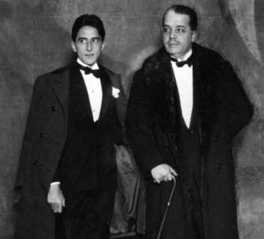 |
|
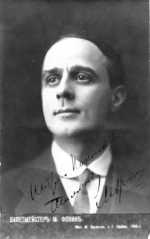 |
|
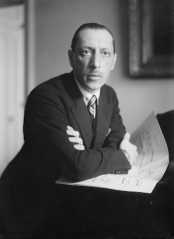 |
| Jean
Cocteau & Serge
Diaghilev |
|
Mikhal
Fokine |
|
Igor
Stravinsky |
| |
|
|
|
|
At
last, the house lights
dimmed, the audience
hushed and the orchestra
struck up the
introductory music. There
was no medley
played by the band as
we had at the Hackney and
no applause for their
efforts either. The introduction
was slow and remarkably
quiet and continued for a
few minutes before the
curtain slowly parted to
reveal a simple scene.
There was a mock-wall
with a large open French
window and one small
chair close by –
nothing else. Again it
should be remembered that
at my young age, abstract
design was not
understood by me. Again
after a few more minutes
of this dull music, a
woman in a three-quarter
length white net dress
walked onto the stage
carrying a small rose in
her hand.
The first
piece that we were about
to see was called Le
Spectre de La Rose. The
story line starts with
the return of a young
girl from her first ball
and is carrying a rose as
a momento of her
evening. She sits down in
a chair and soon falls
asleep and dreams that
she is dancing with the
rose. I have to
confess that I most
certainly did not
appreciate that this was
what I was watching at
all.
The
principal male dancer of
the company obviously
danced the role of The
Rose. What I was
about to see can only be
described as dazzling!
It was something that
I had not expected and
although it did
not win me over to
ballet, it certainly
impressed me and quite blew
me away at the time!
Suddenly, the tempo
of the music changed from
what I thought of as
being miserable, to
something rousing and
alive. Along with
the change in music came
the most remarkable and
spectacular entry that I
had ever seen anyone make
onto a stage. Quite
suddenly a figure literally
flew onto the
stage by making the most
magnificent leap
imaginable through the
open French windows at stage
left and then
immediately went into a vole
of amazing and
successive leaps and
jumps. I had never seen
anything like this at the
Hackney! I was
completely mesmerized by
his amazing flyings
through the air! I
cannot say if this
amazing feat of dance
was greeted by applause
or not
since I was totally and
utterly captivated by
what I was witnessing.
Following
several minutes of such
remarkable athleticism, I
was physically exhausted
and almost welcomed the
awakening of the
young girl. When she
stood up, the couple
danced about the stage in
a much less interesting
manner. To be honest, I
would have much preferred
her to continue her
sleeping, as I was not
impressed with what I
took for their skipping
about the stage,
which she did en
points. Once I was
revived, I was ready for
more leaps and bounds by Le
Spectre. Mercifully,
after several minutes of
their cavorting
back and forth, the young
girl appeared to collapse
back into her chair
and soon nodded off once
more, leaving The
Spirit free to leap
and jump as he chose and
to treat us to a final
magnificent leap out of
the open window. After
seeing this, what else is
left to say?
I later
learned that Le
Spectre de la Rose
is a ballet based on a
poem by Theophile
Gautier with music by
Carl Maria von Weber.
The musical piece was
introduced in 1819 for
the piano and was
entitled Invitation to
the Dance. In 1841, it
became fully orchestrated
by Berlioz. The
ballet premiered in 1911
at Monte Carlo with
Nijinsky as Le
Spectre and Tamara
Karsavina as the
young woman.
Following
that final and
spectacular leap through
the French windows, the
curtains from the sides
of the stage slowly
closed and the audience
exploded into joyous
applause. I must say that
I doubt if anyone clapped
louder than me following
the performance. After
this, the principal
dancers paraded themselves
before the drawn curtains
and bowed deeply to the
audience. I remember
noting that the dancers
walked in a very strange
manner, which I had never
seen before. It was a
slow and deliberate walk
and not at all akin to
how normal people
walk down the street.
They appeared to lean
back, thrust out their
chins and maintain their
backs in an arched
position. Their legs
seemed no longer to bend
at the knees and their
feet pointed downwards.
They moved or
rather glided
slowly and deliberately
and they gave no smiles
to the audience as they
did. I was not used to
performers and
entertainers taking bows
after their stint
in such a grand and
exaggerated manner and I
was most certainly not
used to performers not
smiling at the audience.
And as for that walk,
I had never seen anything
like that before! It was
akin to a goose step, but
performed more slowly and
deliberately. Once home,
I remember describing the
walk to my father,
and within minutes, both
he and I were found parading
about the kitchen
with our noses in the air
and with our knees locked
and our feet pointed
straight out, much to the
amusement of my mother.
To be honest, this walk
requires practice
since one needs to have a
good sense of balance to
perform it correctly or
else risk toppling over!
Regardless
of the difficulty of
performing this walk, I
was not impressed by it.
At the Hackney, performers
took a bow at the
end of their act and when
they did, they smiled as
they bowed and then they
thanked the audience and
were gone. Following this
short show of gratitude
and its acceptance, the bandleader
struck up the musical
introduction to the
next act and the curtains
would part and we were
ready to be treated to
something new.
The
dancers of the ballet did
not seem to know when to
leave the stage for they
bowed, or rather the man
bowed deeply and
the woman curtsied again
and again. The curtsy was
somewhat amusing too. It
was exaggerated in that
the woman performed it
very low, so much so that
I thought that she would
almost sit on the stage
in doing it! Neither of
them smiled or appeared
to show any emotion as
they accepted the
applause and cheers.
Following their bow, they
disappeared behind the
curtain that was held
open for them by unseen
hands. The male dancer
made much of allowing the
woman to pass before him
and so disappear first.
He bowed graciously
– long and deep
– as she passed and
she, for her part, nodded
her head in
acknowledgement.
Everything seemed very
formal to me. Almost
immediately after
disappearing behind the
curtain, they returned
and we next had to sit
through this whole ritual
again. During the
return, someone
rushed up to the stage
with flowers and handed
them to the woman. She
accepted them with yet
another bow of her head
and she and the person
exchanged the slightest
brush of each cheek. I
had never seen kissing
like this before and
wasn’t sure what to
make of it. I noted that
the male dancer – the
star, as far as I was
concerned – received
no present! This did not
seem fair to me since she
– the woman dancer
– had apparently slept
in her chair for most
of the performance and
added little to the joie
given to us.
 I
certainly did not
appreciate their
continual bowing and
constant disappearing
behind the curtain only
to immediately return
again. Despite my
wish to re-see Le
Spectre following his
performance, I did
not wish to see him out-of-character
and I did not wish to
see him to-ing and
fro-ing in this
manner. I also could not
understand why they
bothered leaving the
stage in the first place
if they were planning to
return to it immediately.
As we used to say in the
East End at such times
….. enough
already! Obviously,
at that young age I had
no concept on how to
milk an audience. I
certainly did not
appreciate their
continual bowing and
constant disappearing
behind the curtain only
to immediately return
again. Despite my
wish to re-see Le
Spectre following his
performance, I did
not wish to see him out-of-character
and I did not wish to
see him to-ing and
fro-ing in this
manner. I also could not
understand why they
bothered leaving the
stage in the first place
if they were planning to
return to it immediately.
As we used to say in the
East End at such times
….. enough
already! Obviously,
at that young age I had
no concept on how to
milk an audience.
Following
a few more of these encores,
I decided that they had
received enough claps and
was beyond being ready
for them to go and not
return. I remember
thinking that this mob
needed to come to the
Hackney and learn
how to take a bow and
get off! I much
preferred the quick
bow at the end of an
act and then, following
the finale, I
liked to see everyone
return – act
followed by act in
the order of their
performance – where
they once more could
enjoy a quick individual
bow followed by several
collective bows taken by
the whole ensemble
cast. This new way of
taking a bow was
confusing to me. Finally,
to top-off my irritation,
the band leader now
appeared on stage and
after receiving numerous
hugs and kisses from the principals,
there was more bowing to
endure! By now, I needed
to be restrained in my
seat!
At long
last the dancers finally
left the stage. Now I was
able to ask the many
questions that I had
about what I had seen. I
had not realized that the
young girl of the piece
had been dreaming.
I was still seeing things
and interpreting what I
saw in a literal
manner. Most
certainly I was too young
to see such a production
without first having some
introduction as to
what I was about to see.
I felt sorry for my poor
mother since she was not
able to answer every
question that I asked.
Luckily for her, my
questions were too
numerous to be dealt with
during the short
intermission since much
of the time was taken up
with the trying to buy an
ice cream and
enjoying it. Soon we had
to ready ourselves for
the next piece.
Naturally, I was
expecting to see the
return of The Spectre, but
alas no, instead I was
treated to what appeared
to be three dancing
rag dolls, none of
whom were any great
shakes when it came
to leaping!
The second
piece presented for our
pleasure that evening was
excerpts of the ballet Petruchka
(also spelled Petrouchka)
with music by Stravinsky.
This ballet is the
story of a Russian
traditional puppet, Petruchka,
who is made of straw
and sawdust and who is
brought to life by a
magician and who develops
human emotions.
Naturally, it ends badly.
It was produced first at
the Theatre du
Chatelet in Paris by Diaghilev’s
Ballets Russes in
1911. Mikhail Fokine provided
the choreography and
Nijinsky danced
the principal role. The
ballet itself was
generally well-received,
but many criticized the
music as being brittle,
caustic, and at times
even grotesque. At
the time, I could have
attested to this.
However, it should be
remembered that, at that
time, I only knew more melodic
tunes or as an
ex-friend of mine once so
charmingly put it when
complaining about the
score of Sondheim’s
A little Night Music
……. more
foot-tapping tunes! I
have learned that the
work is characterized by
the so-called Petrushka chord
(consisting of C major
and F# major
triads played
together), a bitonality
device heralding the
appearance of the main
character. Further
information about the
ballet may be obtained
at:
http://en.wikipedia.org/wiki/Petrushka_(ballet)
I cannot
say that I was especially
taken with this
ballet however it must
have had some effect on
me since I remembered it
well when I saw it again
once I was older. The
setting was at a pre-Lent
fairground in Russia. I
remember the colours of
the set was garish and
not to my taste at all.
To the right, there was a
small open-air theatre
where three lifeless
human-sized puppets hung.
They hung in such a
convincing manner that I
was certain that they
lacked bones. The puppets
were of a Moor, a Ballerina
and a clown-like
creature, Petrushka.
A magician dances about
the stage, captivating
the audience as he
pretends to play a flute.
I remember telling my
mother at this point that
a man in the band was
really playing the
instrument and being told
to be quiet for my
pains. I decided that I
would not offer my
help again that
evening!

The
magician obviously must
have woven a spell, as
the dolls come to life
and began to dance
somewhat vigorously about
the stage. I was
quite taken with this
achievement and with the
dancing since it was lively
and immediately wanted to
share this with my
mother. But after being rebuffed
earlier, I decided to
keep my opinions to
myself. Like most
children of my age, I did
not take rejection well
and had not yet learned
that being told to be
quiet did not mean never
speak to me again!
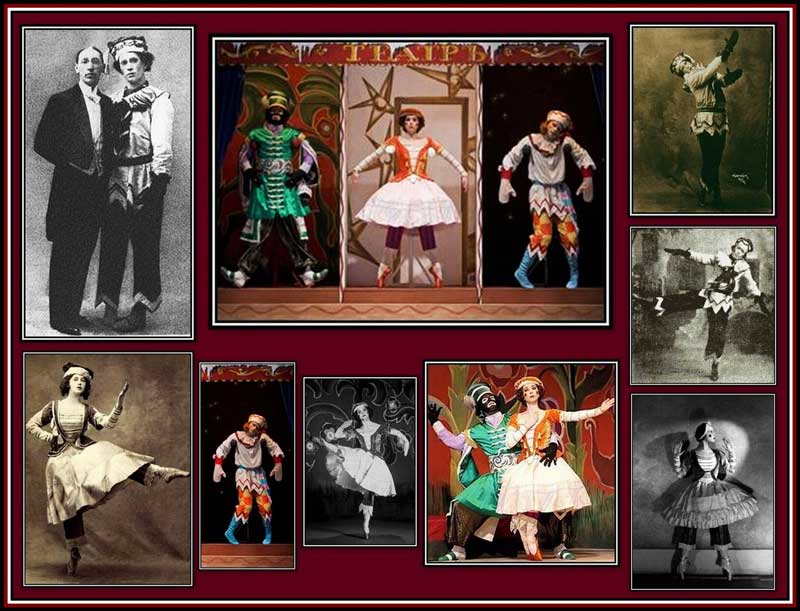
The ballet
is in four scenes, but I
do not recall being
treated to each. From
what I remember of the
production, I think that
the company danced two
scenes only: the first
and then possibly the
final one. As I remember
the story that first time
of seeing the ballet, Petrushka
fell in love with the
Ballerina and the Moor
was his rival.
Obviously somewhere in the
telling of the tale, Petrushka
gets rejected. What I
remember especially was
the finale of the
piece: Petrushka had
completed a tearful dance
following his rejection
and at the end of the sad
dance, the Magician returned,
grabbed hold of him and
threw him out of the
door. Whereupon the
curtain slowly and
effectively closed
leaving the poor, broken
and rejected puppet
crawling slowly and
painfully off the stage.
I was quite upset by
this. I was pleased that
the curtains had been
drawn as I could not
control myself and needed
to discuss this
cruel and callous fate of
Petrushka!
Fortunately my mother
found the ending to be
sad and we commiserated
and consoled each other
over it. Art, like life,
can be so cruel at times!
Excerpt
from the ballet Petrushka
– http://www.youtube.com/watch?v=N8RSlT7qbAY
I cannot
recall anything about a
third or a fourth piece
presented to us that
evening at the Stoll. Anyway,
on the whole my first
experience with The
Ballet had not been
as awful as I
thought it would be. I am
unable to say that I
became a devotee of
the art form immediately
following it, but I
learned through more
viewing to enjoy it. What
finally convinced me of
the greatness of the
ballet were two
events.
 At
one time the BBC presented
speciality programmes
for a minority audience
with greater regularity
than they do now. An
example of such
programming was the Master
Class series. These
programmes were
memorable. Here musical
virtuosos, such as
the wonderful Jacqueline
du Pre,
would conduct
a class for one or two
talented young musicians,
and we, the television
audience, would be privee
to it. I found these classes
stimulating. Another
series took the audience inside
a ballet class
and to an actor’s
studio. These
programmes were
remarkable and gave
television viewers some
insight into exactly what
is required of these
students and what they
need to do to master
their art. Each programme
left the viewer with a
new respect for
those that are prepared
to dedicate their lives
to perfect their talent.
I think that it was
the Ballet Class that
had the greatest effect
on me. I was amazed at
how hard the dancers
worked before they
ever got to dance a piece
– the stretching,
the endless practice at the
bar and the tolerance
of the often brutal
criticism barked at them.
I have never been able to
see a ballet since
without recalling that
particular programme and
remembering what the
dancers went through in
order to dance that
evening. At
one time the BBC presented
speciality programmes
for a minority audience
with greater regularity
than they do now. An
example of such
programming was the Master
Class series. These
programmes were
memorable. Here musical
virtuosos, such as
the wonderful Jacqueline
du Pre,
would conduct
a class for one or two
talented young musicians,
and we, the television
audience, would be privee
to it. I found these classes
stimulating. Another
series took the audience inside
a ballet class
and to an actor’s
studio. These
programmes were
remarkable and gave
television viewers some
insight into exactly what
is required of these
students and what they
need to do to master
their art. Each programme
left the viewer with a
new respect for
those that are prepared
to dedicate their lives
to perfect their talent.
I think that it was
the Ballet Class that
had the greatest effect
on me. I was amazed at
how hard the dancers
worked before they
ever got to dance a piece
– the stretching,
the endless practice at the
bar and the tolerance
of the often brutal
criticism barked at them.
I have never been able to
see a ballet since
without recalling that
particular programme and
remembering what the
dancers went through in
order to dance that
evening.
The other
great event which caused
me to finally rethink my
attitude towards dance
and ballet in
particular took place in
1960. I was now in the fifth
form and had
discovered modern jazz
and the cool.
I remember that I had
just acquired a 45 ‘record
of Andre
Previn’s Like Young
and thought it one of
the greatest tunes that I
had ever heard. I had
heard snippets of
his jazz version of My
Fair Lady
while Down the
Lane and was
determined to save up
enough money to buy the
album. Sadly, I never
did! I had made friends
with a small group of
kids at school who were very
arty and two of them
eventually went off to
the Central School of
Acting in London and
had careers on the stage
and television. We
thought ourselves very avant
garde and went to jazz
clubs and rubbed
shoulders with the
remaining Beatniks that
were around. We also went
to the theatre in
the West End. We
happily and willingly sat
on those awful wooden
forms at The Old Vic. As
wonderful as the plays
were, I am not sorry to
see those forms replaced!
We lined up for seats in
the Balcony at
other theatres and saw
many great plays and
performers and marched
each Easter from
Aldermaston to London
during the Ban the
Bomb Campaign years
and happily slept in
those vast marquees.
We thought ourselves too
cool to go and see musicals
at the theatre and
sneered at those being
produced until one
extraordinary and
ground-breaking one
arrived on the London
stage and set about
changing our attitudes.
This was West Side
Story.
We
had heard of West Side
Story long before it
arrived in London. We had
heard of its realistic
story line and its
remarkable operatic and
classically inspired
music. But most of all,
we had heard of the dancing!
I remember reading
article after article
about the brilliance of
someone called Jerome
Robbins. I read about
him and learned that he
had been trained in ballet!
I could not believe
that anyone trained in ballet
would be able to cross
over and also dance
for the average
theatre goer. I noted
the awards that the show
had won in New York and I
was pleased to learn that
a London Production was
soon to be forthcoming.
We could not wait.
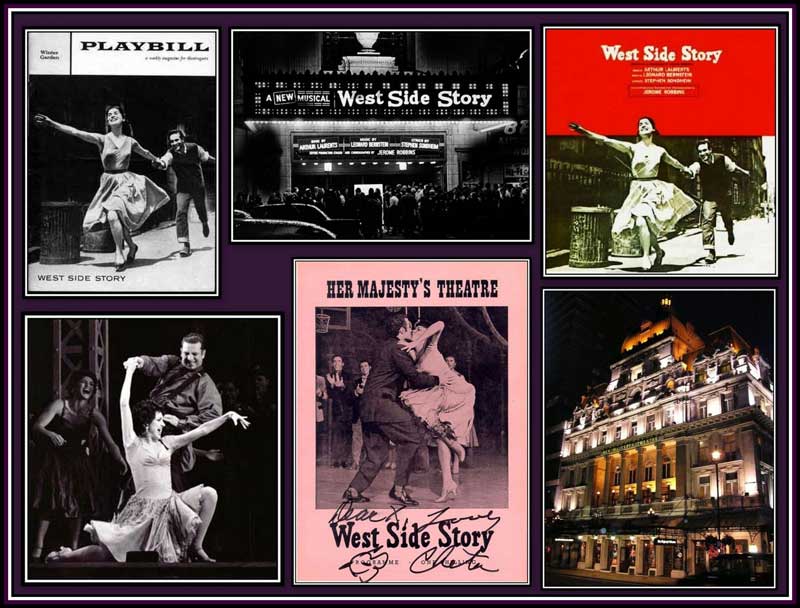
 |
|
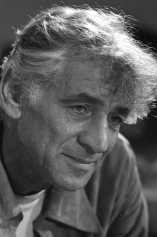 |
|
 |
| Jerome
Robbins |
|
Leonard
Bernstein |
|
Stephen
Sondheim |
 Eventually
the London Production
of West Side Story opened
and it was a revelation.
The dancing was
spectacular. We wanted plimsoles, as gym shoes,
tennis shoes and trainers were once called. We
wanted white socks too.
And we all wanted to glide
down the street as The
Jets did in the Prologue.
However, what I wanted
most of all was to dance
with Anita! I
remember that it was Chita
Rivera who played the
role of Anita and
I had never seen such
spectacular dancing as
when she and Bernardo took
the floor and Danced
at the Gym! The mambo was
and still is one of the
most spectacular dances
ever! Eventually
the London Production
of West Side Story opened
and it was a revelation.
The dancing was
spectacular. We wanted plimsoles, as gym shoes,
tennis shoes and trainers were once called. We
wanted white socks too.
And we all wanted to glide
down the street as The
Jets did in the Prologue.
However, what I wanted
most of all was to dance
with Anita! I
remember that it was Chita
Rivera who played the
role of Anita and
I had never seen such
spectacular dancing as
when she and Bernardo took
the floor and Danced
at the Gym! The mambo was
and still is one of the
most spectacular dances
ever!
There is
perhaps one criticism of
the stage production that
I offer. Although America is brilliantly danced
by the Puerto Rican
girls, they lack a
suitable foil to
dance against in
the stage production.
Mercifully, this is
rectified in the film
version. Here the
remarkable Rita
Moreno, now
brilliantly playing Anita and the equally
spectacular George
Chikaris, playing Bernardo, dance and battle each
other to the music of America.
George Chikaris had
played Riff on the
London stage, and
although he did this
brilliantly, for the film
version he now changed gangs, and proved even more
remarkable in the role of Bernardo. This
version of America has not been equalled! |
|
| Since
1960, I have seen West
Side Story many
times, both on film and
on stage. Last year I saw
two new productions
within a few months of
each other: the first was
a new Broadway production
where an exciting and
brilliant Anita was born, as was
a wonderful new
production of Dance
at the Gym.
The second production was
presented by the Stratford
Shakespeare Festival in Ontario, Canada. This
production was a
revelation since it was
here, for possibly the
first time in all of the
times that I have seen
the show, I immediately
liked the person playing Maria. In all fairness, I
have to confess that I
have learned to
accept and even like Natalie
Wood in the role and
now readily admit that
she did not do a bad
job, but it is that
young woman at Stratford that will, for me at
any rate, symbolize Maria from now on. Now, at
last, I can fully
appreciate exactly why Tony risked everything for
her. When he sings Something’s
coming, he was surely right!
And when Riff off
handedly remarks that maybe
what you’re waiting
for’ll be
twitchin’ at the
dance tonight! For
once, he was right! Yeah!
Who knows! |
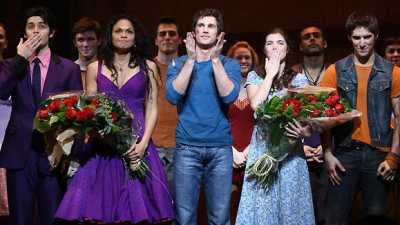 |
|
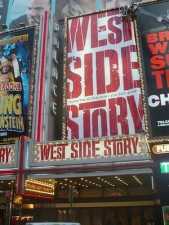 |
|
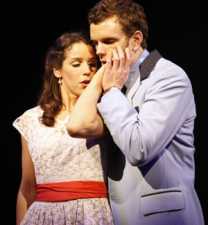 |
| The New
Broadway Cast |
|
The Palace
Theatre |
|
Stratford's
Tony & Maria |
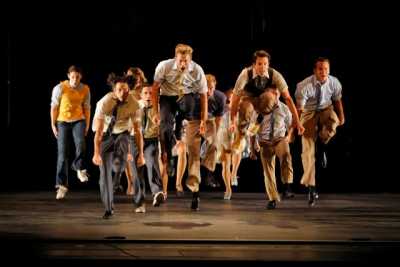 Anyway,
Dancing at the Gym and
America finally
did it for me! And over
the years, I have had to
add the brilliant Cool
to this list. The
sheer energy needed to
dance this piece, the
frantic excitement that
it generates and the
dedication of the dancers
combine to elevate dance
to a new and yet another
dizzy height. Since then,
I have never been able to
look at a parking
garage in quite the
same way again or stop
myself from clicking my
fingers and attempting to
move as these kids
did back in 1961. Anyway,
Dancing at the Gym and
America finally
did it for me! And over
the years, I have had to
add the brilliant Cool
to this list. The
sheer energy needed to
dance this piece, the
frantic excitement that
it generates and the
dedication of the dancers
combine to elevate dance
to a new and yet another
dizzy height. Since then,
I have never been able to
look at a parking
garage in quite the
same way again or stop
myself from clicking my
fingers and attempting to
move as these kids
did back in 1961.
These
excerpts from West
Side Story are
brilliant examples of the
art ballet! And so
is what the Nederlands
Dans Theatre
presents, as are the
productions which The
Royal Ballet
offers at Covent
Garden and the films
of Gene Kelly and
the wonderful works
of The
Australian Ballet
and everything
presented by the many
smaller dance troupes
around the world
including the great Jose
Limon Dance Company.
I will even extend my
definition to include
those great GAP commercials
of a few years ago where dance
was used brilliantly,
the best of which, as far
as I am concerned, was
the swing
dance.
My list could go on
and on and is in fact
endless. It is decidedly
true to say that I have
developed a vast
appreciation for dance
over the years and
see it whenever I can.
One last
point regarding my first
trip to the ballet, which
had pronounced and severe
repercussions! As I said,
I was very impressed with
Le Spectre, especially
his leaps. On our way
home that evening, I had
to be restrained as I
wanted to leap home
and was somewhat annoyed
with myself since I was
unable to achieve the
heights that he
reached. Once
home, I gave my father a
version of what I had
seen earlier. Since he
had had a few bevies and
was in a relaxed mood, he
joined me and together we
pranced and leapt
about the room. After a
bit, my mother asked him
to stop encouraging me
and said that if I
did not calm down, I
would hurt myself.
Naturally no one listened
and we continued with our
leaping and our jumping.
After a
bit, my father returned
to the kitchen to make a
cup of tea for us and my
mother went upstairs for
some reason. And so I was
left alone in the living
room. This was when the big
mistake took place!
As I have said, despite
my efforts, I was not
able to reach the
heights in my leaps
that I wished. This was
much to my annoyance. And
then I thought that if I
were to start out at a
higher point, I might
then be able to give my
father a better
impression of the
brilliance of Le
Spectre. I decided to
climb up onto an armchair
and leap from
there! Unfortunately I
still could not obtain
sufficient spring to
leap high enough since my
foot sank into the
cushion and limited my take
off. And then it
occurred to me that if I
turned the armchair
around and stood on top
of the back, I would be
standing on something
firm and would be able to
fly!
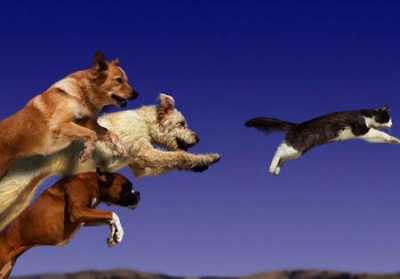 I
decided to rehearse my
leap before my
audience returned. I
managed to turn the
armchair around so that
the back faced into the
room. I then climbed up
on the cushion of the
seat. Naturally, in my
excitement I had
forgotten to prepare the
room for my leap! Being
young, and not yet having
studied physics and
knowing nothing of forces,
gravity or moments,
I was not fully aware
of what I was about to
do. I was now standing on
the cushion of the seat
and on then realized that
my legs were not long
enough to allow me to put
one foot on the top of
the chair back and hoist
myself up and stand aloft.
And so stupidly, I tried
to scramble up the
back and reach the
summit this way! No
sooner had I started my
ascent than I found
myself, and the chair,
falling forwards. Within
a split second, the
armchair fell backwards
taking me with it. Along
with the fall, I found
myself flying
through the air in a manner not quite
as I had hoped. My aborted
leap nonetheless
carried me forward and propelled me in the direction of my
mother’s coffee
table! Tragically, a crash
landing was
inevitable! I
decided to rehearse my
leap before my
audience returned. I
managed to turn the
armchair around so that
the back faced into the
room. I then climbed up
on the cushion of the
seat. Naturally, in my
excitement I had
forgotten to prepare the
room for my leap! Being
young, and not yet having
studied physics and
knowing nothing of forces,
gravity or moments,
I was not fully aware
of what I was about to
do. I was now standing on
the cushion of the seat
and on then realized that
my legs were not long
enough to allow me to put
one foot on the top of
the chair back and hoist
myself up and stand aloft.
And so stupidly, I tried
to scramble up the
back and reach the
summit this way! No
sooner had I started my
ascent than I found
myself, and the chair,
falling forwards. Within
a split second, the
armchair fell backwards
taking me with it. Along
with the fall, I found
myself flying
through the air in a manner not quite
as I had hoped. My aborted
leap nonetheless
carried me forward and propelled me in the direction of my
mother’s coffee
table! Tragically, a crash
landing was
inevitable!
It is
amazing how many thoughts
pass through one’s
mind in a so-called split
second! As I found
myself being projected
forward, I realized
that I was going to be in
the most trouble ever
once I landed! I also
realized that my
mother’s coffee
table was hard and had
sharp corners and there
was a chance – a
very good chance –
that it would object to
being landed on and would
most likely fight back
and do me injury! I
also realized that
although the coffee table
would most likely hurt
me, I would most
likely hurt it in
return.
 My
mother’s coffee
table was new. She had
recently bought it to
replace an older and much
heavier table that she
had had for years. The
old table had stout
carved legs and no doubt
would have been more than
able to sustain heavy
objects being dropped on
it. In that split
second I also recall
wishing that she had that
table still! She had
purchased a new and
rather flimsy table
with four thin legs. I
believe that the piece of
furniture was in a modern
style known as G-Plan.
G-Plan furniture was
sold by Times
Furnishings, which
had shops everywhere at
the time and were pushing
this more modern
and convenient style of
furnishings. The
table was light and again
during that split
second of my trajectory
I knew that it would
not support such an onslaught
as it was about to
suffer. My
mother’s coffee
table was new. She had
recently bought it to
replace an older and much
heavier table that she
had had for years. The
old table had stout
carved legs and no doubt
would have been more than
able to sustain heavy
objects being dropped on
it. In that split
second I also recall
wishing that she had that
table still! She had
purchased a new and
rather flimsy table
with four thin legs. I
believe that the piece of
furniture was in a modern
style known as G-Plan.
G-Plan furniture was
sold by Times
Furnishings, which
had shops everywhere at
the time and were pushing
this more modern
and convenient style of
furnishings. The
table was light and again
during that split
second of my trajectory
I knew that it would
not support such an onslaught
as it was about to
suffer.
I crashed
onto the table. I
remember that the splayed
legs, which had
looked so elegant,
so modern promptly
splayed outwards
to a maximum and the
tabletop collapsed to the
floor under my weight.
The sound of me landing
on the table and then of
the legs and tabletop
collapsing would have
most certainly have
caused both of my parents
to leave what it was that
they were doing and rush
to the room. However,
what probably caused them
to increase the speed of
their step and rush to my
side was the blood
curdling and deeply
guttural cry that
exploded from my lips as
my person reached
the ground!
In an
attempt to save
myself, again in that
famous split second, I
had brought my hands up
to my face. This may have
saved teeth being
knocked out and noses
from being damaged, but
it exposed my elbows to
danger.
I lay
there on top of that
broken coffee table and
knew that I was hurt. Belly
flopping onto the
table had caused most of
the available air in my
lungs to be forced out of
me and so I was able to
offer only that one cry,
which alerted my
parents to the doom that
had overtaken me. I could
feel pain suddenly
overtake me, but I was
unable to speak. I was winded!
My father reached me
first and inspected me to
assess the damage! When
my mother arrived, she
too inspected me and then
they compared notes like
good physicians and
decided on what exactly I
had done to myself. It
was decided that I had
indeed hurt my elbows?
But how seriously? Should
I be taken to the
hospital now, or could it
wait until the morning?
Should I go to the Children’s
Hospital in Hackney
Road or to The
London Hospital on
the Whitechapel Road found
a few yards up the road
from the pie
‘n’ mash shop? These
burning questions
needed answering and
answering soon. The Pros
and Cons of each
solution was carefully
weighed. I was now able
to give some impute,
as I had regained my
wind and was able to
breathe again, but not
without some pain I might
add. But despite having
to endure sharp pain, I
managed to express my
displeasure and distress.
Like all people hurt,
mostly through their own
fault, I began to cry and
to cry loudly. My father
was always the one to weaken
first whenever I
cried. I had already
realized that I could get
anything out of him and
twist him around my
little finger if I
were to cry. He never
learned to distinguish real
tears from what my
mother called crocodile
tears.
|
The
Children's Hospital,
Hackney Road - now sadly
left derelict |
My wailing
must have convinced
my parents that there was
a chance that I was more
hurt than they had
previously thought and,
as a result, I was soon wrapped
up in a blanket and
then swept up in
my father’s arms to
be carried to The
London Hospital. I
will talk more about this
hospital later, since it
is a place that loomed
prominently in my
mother’s early life
and was a place that she
dreaded ever having to go
to.
|
The Royal
London Hospital,
Whitechapel Road |
I was
taken to the Emergency
and was quickly assessed,
diagnosed and treated.
The Emergency at
that time was far from
being what they have
become today. Emergency
departments were busy
immediately after the pubs
closed and generally
throughout the whole of
Friday, Saturday and
Sunday nights. During the
week, nights were mostly
quiet. Examination and X-ray
demonstrated that I
had chipped my right
elbow and severely bruised
my left. My right
elbow was put in a
cast, which extended
from my mid upper arm
almost down to my wrist.
My left arm was put in a sling
and I was told not
to overuse it! There
was certainly no fear of
that, I thought,
especially since the left
elbow hurt much more than
the right. I have always
sworn that they got the
arms mixed up that night!
My poor
father probably suffered
the most as a result of
my Nijinsky-esque
flying leap. My
mother accused him of both
instigating and
encouraging the leap
and demanded that he buy
her a new coffee table as
compensation. I was not let
off the hook as one
might think, especially
seeing that I was wounded.
Once we returned home
from the hospital, my
mother verbally
scolded me several
times and would continue
to do so whenever I
offered the merest
complaint about my
condition. I was also
denied the right to leave
the shop alone while in
my current condition.
This was the worst of tortures
since it meant that I
was no able to go
on my rounds, as I
liked to call my
wanderings up the
Waste to visit my
friends and their stalls.
This meant not going to Paul’s
and also not going to
Mr. G’s. The
price of my punishment
was too much to bear!
Fortunately, my
mother’s annoyance
and apparent anger was
not real, but came from
her relief that I had not
injured myself more
severely. And soon, she
was accompanying me on
my rounds and every
one of note and
importance in my life at
that time were pampering
and spoiling me.
The
saddest of the
repercussions that came
from my attempt to follow
in the steps and leaps of
Le Spectre was
that I developed a
fear of heights and
have never been able to walk
a thin beam or climb
a rope above my height
for fear of falling and
breaking more bones.
Since that day, I have
been careful to maintain
my feet firmly on terra
ferma. Happily, or
unhappily, my leaping days
were over.

|